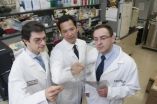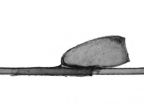(Press-News.org) In December 2013, the U.S. Food and Drug Administration approved the first high-throughput DNA sequencer (also known commonly as a "gene sequencer"), an instrument that allows laboratories to quickly and efficiently sequence a person's DNA for genetic testing, medical diagnoses and perhaps one day, customized drug therapies. Helping get the new device approved was another first: the initial use of a reference set of standard genotypes, or "coded blueprints" of a person's genetic traits. The standard genotypes were created by the National Institute of Standards and Technology (NIST) and collaborators within the NIST-hosted Genome in a Bottle consortium.
"Two years ago, NIST hosted Genome in a Bottle—a group that includes stakeholders from industry, academia and the federal government—to develop reference materials that could measure the performance of equipment, reagents and mathematical algorithms used for clinical human genome sequencing," says NIST biomedical engineer Justin Zook. "Our goal is to provide well-characterized, whole genome standards that will tell a laboratory how well its sequencing process is working, sort of a 'meter stick of the genome.'"
Modern DNA sequencers take a genetic sample in the form of long strings of DNA and randomly chop the DNA into small pieces that can be individually analyzed to determine their sequence of letters from the genetic alphabet. Then, bioinformaticians apply complex mathematical algorithms to identify from which part of the genome the pieces originated. These pieces can then be compared to a defined "reference sequence" to identify where mutations have occurred in specific genes.
There are several different DNA sequencing technologies and computer algorithms to do this very complex analysis, and it's known that for any given sample, they will produce similar, but not identical results. Built-in biases as well as what are essentially "blind spots" for certain possible sequences contribute to uncertainties or errors in the sequence analysis. "These biases can lead to hundreds of thousands of differences between sequencing technologies and algorithms for the same human genome," Zook says.
In a recent paper in Nature Biotechnology,* Zook and his colleagues describe the methods used to make the Genome in a Bottle consortium's pilot set of genotype reference materials. The source DNA, known as NA12878, was taken from a single person. The reference set is essentially the first complete human genome to have been extensively sequenced and re-sequenced by multiple techniques, with the results weighted and analyzed to eliminate as much variation and error as possible.
"We minimized bias in our reference materials toward any specific DNA sequencing method by comparing and integrating data from 14 sequencing experiments generated by five different sequencing platforms," Zook says.
The findings in the Nature Biotechnology paper are publicly available from the Genome in a Bottle website, http://www.genomeinabottle.org. In addition, the Genome Comparison and Analytic Testing (GCAT) website enables real-time benchmarking of any DNA sequencing method using the paper's results. The research was conducted by a team of scientists at NIST; Harvard University; the Virginia Bioinformatics Institute at Virginia Tech University; and an Austin, Texas, genetic company, Arpeggi Inc. (now part of Gene by Gene Ltd.).
After characterizing the NA12878 pilot, samples of the DNA will be issued as a NIST Reference Material. The Genome in a Bottle consortium also plans to develop well-characterized whole genome reference materials from two genetically diverse groups: Asians and Ashkenazi Jews. Both reference sets will include sequenced genes from father-mother-child "trios" to utilize genetic links between family members.
INFORMATION:
For more information on the Genome in a Bottle consortium, go to http://www.genomeinabottle.org.
* J.M. Zook, B. Chapman, J. Wang, D. Mittelman, O. Hofmann, W. Hide and M. Salit. Integrating human sequence data sets provides a resource of benchmark SNP and indel genotype calls. Nature Biotechnology Published online Feb. 16, 2014. doi:10.1038/nbt.2835
'How well did you sequence that genome?' NIST, consortium partners have answer
2014-02-25
ELSE PRESS RELEASES FROM THIS DATE:
Talking in 3-D: Discussing and administrating complex construction models via a web browser
2014-02-25
Redevelopment of the London King's Cross station and the nearby neighborhood was announced in 2005 and completed with a grand opening in 2012. The internationally well-recognized engineering services firm Arup, famous among other things for their work on the Opera House in Sydney, Australia, and the Allianz Arena in Munich, worked on this 400 million pound construction project. In the process, the area to the north of the station including 50 new buildings, 2,000 new apartments, 20 new streets and ten new public squares was being renewed. Thus, a great challenge was to ...
Air Force aircraft returned from Vietnam is postwar source of Agent Orange contamination
2014-02-25
February 25, 2014 -- From 1971-1982, Air Force reservists, who flew in 34 dioxin-contaminated aircraft used to spray Agent Orange and returned to the U.S. following discontinuation of the herbicide spraying operations in the Vietnam War, were exposed to greater levels of dioxin than previously acknowledged, according to a study published today in Environmental Research by senior author Jeanne Mager Stellman, PhD, professor emerita at the Mailman School of Public Health's Department of Health Policy and Management.
"These findings are important because they describe ...
New clues found to preventing lung transplant rejection
2014-02-25
Organ transplant patients routinely receive drugs that stop their immune systems from attacking newly implanted hearts, livers, kidneys or lungs, which the body sees as foreign.
But new research at Washington University School of Medicine in St. Louis suggests that broadly dampening the immune response, long considered crucial to transplant success, may encourage lung transplant rejection.
In a surprising discovery, the researchers found that newly transplanted lungs in mice were more likely to be rejected if key immune cells were missing, a situation that simulates ...
Ordinary conditioner removes head lice eggs as effectively as special products
2014-02-25
Eggs from head lice, also called nits, are incredibly difficult to remove. Female lice lay eggs directly onto strands of hair, and they cement them in place with a glue-like substance, making them hard to get rid of. In fact, the eggs are glued down so strongly that they will stay in place even after hair has been treated with pediculicides -- substances used to kill lice.
Some shampoos and conditioners that contain chemicals or special oils are marketed as nit-removal products. However, new research just published in the Journal of Medical Entomology shows that ordinary ...
Research links risky behaviors of gambling and sex
2014-02-25
February 25, 2014 -- Late adolescence is a period when many youth become involved in high-risk behaviors with adverse consequences. Researchers at the Mailman School of Public Health with colleagues at Johns Hopkins University studied the degree to which two such behaviors, adolescent sexual behaviors and gambling, affected African American youth in nine primary schools in Baltimore, MD. In data collected from a cohort study, they assessed whether certain adolescent sexual behaviors linked with unintended consequences such as adolescent pregnancy and sexually transmitted ...
Dartmouth-led research shows temperature, not snowfall, driving tropical glacier size
2014-02-25
Temperature, not snowfall, has been driving the fluctuating size of Peru's Quelccaya Ice Cap, whose dramatic shrinkage in recent decades has made it a symbol for global climate change, a Dartmouth-led study shows.
The findings support many scientists' suspicions that tropical glaciers are rapidly shrinking because of a warming climate, and will help scientists to better understand the natural variability of past and modern climate and to refine models that predict tropical glaciers' response to future climate change.
The study appears in the journal Geology. A PDF ...
PFC exposure may spark metabolic changes in overweight children
2014-02-25
Washington, DC—Overweight children who were exposed to higher levels of perfluorinated chemicals tended to show early signs of developing the metabolic syndrome, according to a new study published in The Endocrine Society's Journal of Clinical Endocrinology & Metabolism.
The term metabolic syndrome describes a cluster of risk factors that increase the chances of developing heart disease, stroke and diabetes. The study is the first to find changing metabolic markers in children were associated with exposure to perfluorinated chemicals (PFCs), common industrial chemicals ...
Vitamin D deficiency may compromise immune function
2014-02-25
Washington, DC—Older individuals who are vitamin D deficient also tend to have compromised immune function, according to new research accepted for publication in the Endocrine Society's Journal of Clinical Endocrinology & Metabolism (JCEM).
Vitamin D plays an important role in helping the body absorb calcium needed for healthy bones. The skin naturally produces vitamin D when it is exposed to sunlight. People also obtain smaller amounts of the vitamin through foods, such as milk fortified with vitamin D. More than 1 billion people worldwide are estimated to have deficient ...
Tissue repair drug helps heal diabetic foot ulcers
2014-02-25
Washington, DC—Patients were twice as likely to have a diabetic foot ulcer heal within eight weeks when they were treated with a tissue repair drug versus a placebo, according to new research accepted for publication in the Endocrine Society's Journal of Clinical Endocrinology & Metabolism (JCEM).
Foot ulcers are a common complication from diabetes than can lead to hospitalization and lower limb amputation. In 2006, about 65,700 non-traumatic lower-limb amputations were performed in people with diabetes, according to the Centers for Disease Control and Prevention. Up ...
New study presents evidence that blood pressure should be measured in both arms
2014-02-25
Philadelphia, PA, February 25, 2014 – As heart disease continues to be one of the leading causes of death in the United States, practitioners and patients alike are looking for ways to cut risk factors and identify new clues to assist with early detection. New research published in the March issue of The American Journal of Medicine suggests that there is an association between a difference in interarm systolic blood pressure and a significant increased risk for future cardiovascular events, leading researchers to recommend expanded clinical use of interarm blood pressure ...




